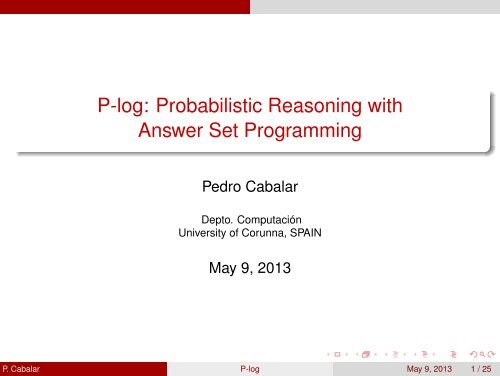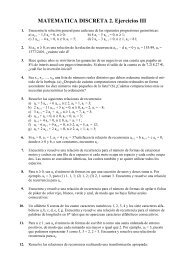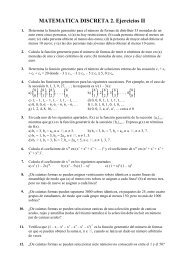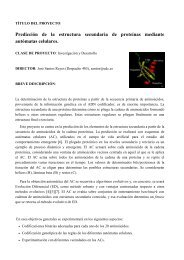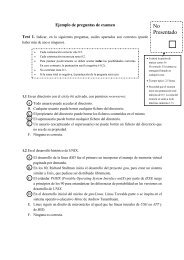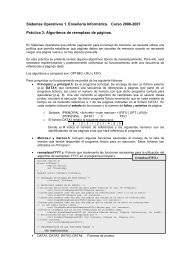P-log: Probabilistic Reasoning with Answer Set Programming
P-log: Probabilistic Reasoning with Answer Set Programming
P-log: Probabilistic Reasoning with Answer Set Programming
Create successful ePaper yourself
Turn your PDF publications into a flip-book with our unique Google optimized e-Paper software.
P-<strong>log</strong>: <strong>Probabilistic</strong> <strong>Reasoning</strong> <strong>with</strong><br />
<strong>Answer</strong> <strong>Set</strong> <strong>Programming</strong><br />
Pedro Cabalar<br />
Depto. Computación<br />
University of Corunna, SPAIN<br />
May 9, 2013<br />
P. Cabalar ( Depto. Computación P-<strong>log</strong> University of Corunna, SPAIN ) May 9, 2013 1 / 25
Outline<br />
1 Introduction<br />
2 P-<strong>log</strong><br />
P. Cabalar ( Depto. Computación P-<strong>log</strong> University of Corunna, SPAIN ) May 9, 2013 2 / 25
Introduction<br />
1 Introduction<br />
2 P-<strong>log</strong><br />
P. Cabalar ( Depto. Computación P-<strong>log</strong> University of Corunna, SPAIN ) May 9, 2013 3 / 25
Introduction<br />
<strong>Probabilistic</strong> reasoning <strong>with</strong> ASP<br />
This chapter is based on:<br />
1 Chitta Baral, Michael Gelfond, Nelson Rushton,<br />
<strong>Probabilistic</strong> <strong>Reasoning</strong> <strong>with</strong> <strong>Answer</strong> <strong>Set</strong>s,<br />
Theory and Practice of Logic <strong>Programming</strong> 9(1), 57–144, 2009.<br />
2 Michael Gelfond and Yulia Kahl,<br />
Knowledge Representation, <strong>Reasoning</strong>, and the Design of<br />
Intelligent Agents,<br />
Chapter 11, <strong>Probabilistic</strong> <strong>Reasoning</strong>.<br />
(book) (to appear).<br />
P. Cabalar ( Depto. Computación P-<strong>log</strong> University of Corunna, SPAIN ) May 9, 2013 4 / 25
Motivation<br />
Introduction<br />
Probability Theory: a well studied and developed branch of<br />
Mathematics.<br />
P. Cabalar ( Depto. Computación P-<strong>log</strong> University of Corunna, SPAIN ) May 9, 2013 5 / 25
Motivation<br />
Introduction<br />
Probability Theory: a well studied and developed branch of<br />
Mathematics.<br />
However, its basic notions are not always intuitive for<br />
commonsense reasoning.<br />
This may make Classical Probability Theory alone not suitable for<br />
KR.<br />
P. Cabalar ( Depto. Computación P-<strong>log</strong> University of Corunna, SPAIN ) May 9, 2013 5 / 25
Motivation<br />
Introduction<br />
Probability Theory: a well studied and developed branch of<br />
Mathematics.<br />
However, its basic notions are not always intuitive for<br />
commonsense reasoning.<br />
This may make Classical Probability Theory alone not suitable for<br />
KR. Let us see a pair of examples.<br />
P. Cabalar ( Depto. Computación P-<strong>log</strong> University of Corunna, SPAIN ) May 9, 2013 5 / 25
Introduction<br />
Example 1. Monty Hall problem<br />
A player is given the choice to select 1 of 3 closed doors. One of<br />
them has a prize and the other two are empty.<br />
1 2 3<br />
P. Cabalar ( Depto. Computación P-<strong>log</strong> University of Corunna, SPAIN ) May 9, 2013 6 / 25
Introduction<br />
Example 1. Monty Hall problem<br />
A player is given the choice to select 1 of 3 closed doors. One of<br />
them has a prize and the other two are empty.<br />
1 2 3<br />
The TV show conductor, Monty, always opens an empty room.<br />
Then, he lets the player switch if he likes.<br />
P. Cabalar ( Depto. Computación P-<strong>log</strong> University of Corunna, SPAIN ) May 9, 2013 6 / 25
Introduction<br />
Example 1. Monty Hall problem<br />
A player is given the choice to select 1 of 3 closed doors. One of<br />
them has a prize and the other two are empty.<br />
1 2 3<br />
The TV show conductor, Monty, always opens an empty room.<br />
Then, he lets the player switch if he likes. Does it really matter?<br />
P. Cabalar ( Depto. Computación P-<strong>log</strong> University of Corunna, SPAIN ) May 9, 2013 6 / 25
Introduction<br />
Example 1. Monty Hall problem<br />
A player is given the choice to select 1 of 3 closed doors. One of<br />
them has a prize and the other two are empty.<br />
1 2 3<br />
It does: he should switch because he has the double chances!!<br />
P. Cabalar ( Depto. Computación P-<strong>log</strong> University of Corunna, SPAIN ) May 9, 2013 7 / 25
Introduction<br />
Example 2. Simpson’s Paradox<br />
Recovery rates for a drug treatment observed among males and<br />
females<br />
Males:<br />
fraction_of_population recovery_rate<br />
drug 3/8 60%<br />
-drug 1/8 70%<br />
Females:<br />
fraction_of_population recovery_rate<br />
drug 1/8 20%<br />
-drug 3/8 30%<br />
A patient P consults the doctor about trying the drug.<br />
P. Cabalar ( Depto. Computación P-<strong>log</strong> University of Corunna, SPAIN ) May 9, 2013 8 / 25
Introduction<br />
Example 2. Simpson’s Paradox<br />
Recovery rates for a drug treatment observed among males and<br />
females<br />
Males:<br />
fraction_of_population recovery_rate<br />
drug 3/8 60%<br />
-drug 1/8 70%<br />
Females:<br />
fraction_of_population recovery_rate<br />
drug 1/8 20%<br />
-drug 3/8 30%<br />
If P is male, the advice is not to take the drug:<br />
0, 7 = P(recover | male, ¬drug) ≮ P(recover | male, drug) = 0, 6<br />
P. Cabalar ( Depto. Computación P-<strong>log</strong> University of Corunna, SPAIN ) May 9, 2013 9 / 25
Introduction<br />
Example 2. Simpson’s Paradox<br />
Recovery rates for a drug treatment observed among males and<br />
females<br />
Males:<br />
fraction_of_population recovery_rate<br />
drug 3/8 60%<br />
-drug 1/8 70%<br />
Females:<br />
fraction_of_population recovery_rate<br />
drug 1/8 20%<br />
-drug 3/8 30%<br />
If P is female, the advice is not to take the drug either:<br />
0.3 = P(recover | female, ¬drug) ≮ P(recover | female, drug) = 0.2<br />
P. Cabalar ( Depto. Computación P-<strong>log</strong> University of Corunna, SPAIN ) May 9, 2013 10 / 25
Introduction<br />
Example 2. Simpson’s Paradox<br />
Recovery rates for a drug treatment observed among males and<br />
females<br />
Males:<br />
fraction_of_population recovery_rate<br />
drug 3/8 60%<br />
-drug 1/8 70%<br />
Females:<br />
fraction_of_population recovery_rate<br />
drug 1/8 20%<br />
-drug 3/8 30%<br />
If P’s sex is unknown . . .<br />
??? = P(recover, ¬drug) P(recover, drug) = ???<br />
P. Cabalar ( Depto. Computación P-<strong>log</strong> University of Corunna, SPAIN ) May 9, 2013 11 / 25
Introduction<br />
Example 2. Simpson’s Paradox<br />
Recovery rates for a drug treatment observed among males and<br />
females<br />
Males:<br />
fraction_of_population recovery_rate<br />
drug 3/8 60%<br />
-drug 1/8 70%<br />
Females:<br />
fraction_of_population recovery_rate<br />
drug 1/8 20%<br />
-drug 3/8 30%<br />
If P’s sex is unknown . . . the advice is taking the drug ?!?<br />
0.4 = P(recover, ¬drug) < P(recover, drug) = 0.5<br />
P. Cabalar ( Depto. Computación P-<strong>log</strong> University of Corunna, SPAIN ) May 9, 2013 11 / 25
Introduction<br />
Example 2. Simpson’s Paradox<br />
The problem has to do <strong>with</strong> causal direction between variables.<br />
P. Cabalar ( Depto. Computación P-<strong>log</strong> University of Corunna, SPAIN ) May 9, 2013 12 / 25
Introduction<br />
Example 2. Simpson’s Paradox<br />
The problem has to do <strong>with</strong> causal direction between variables.<br />
Probability Theory cannot tell whether recovery can be an effect of<br />
drug or vice versa (i.e., when they do not recover, they take the<br />
drug, for instance).<br />
P. Cabalar ( Depto. Computación P-<strong>log</strong> University of Corunna, SPAIN ) May 9, 2013 12 / 25
Introduction<br />
Example 2. Simpson’s Paradox<br />
The problem has to do <strong>with</strong> causal direction between variables.<br />
Probability Theory cannot tell whether recovery can be an effect of<br />
drug or vice versa (i.e., when they do not recover, they take the<br />
drug, for instance).<br />
Judea Pearl’s causal networks are a variant of Bayesian networks<br />
where we can cut a link by causal intervention:<br />
P(recover | do(drug))<br />
means probability of recovering when we fix drug.<br />
P. Cabalar ( Depto. Computación P-<strong>log</strong> University of Corunna, SPAIN ) May 9, 2013 12 / 25
Introduction<br />
<strong>Probabilistic</strong> <strong>Reasoning</strong><br />
[Gelfond & Kahl 13] From a KR perspective, probabilistic<br />
reasoning =<br />
commonsense reasoning about the degree of an agent’s<br />
belief in the likelihood of different events<br />
P. Cabalar ( Depto. Computación P-<strong>log</strong> University of Corunna, SPAIN ) May 9, 2013 13 / 25
Introduction<br />
<strong>Probabilistic</strong> <strong>Reasoning</strong><br />
[Gelfond & Kahl 13] From a KR perspective, probabilistic<br />
reasoning =<br />
commonsense reasoning about the degree of an agent’s<br />
belief in the likelihood of different events<br />
An illustrative example: lost in the jungle you are captured by<br />
natives that will help you to survive if you (blindly) extract a stone<br />
from an urn of the color, black or white, you previously select.<br />
You are told that 9 stones are white<br />
and one is black.<br />
Which color should you tell?<br />
P. Cabalar ( Depto. Computación P-<strong>log</strong> University of Corunna, SPAIN ) May 9, 2013 13 / 25
<strong>Probabilistic</strong> models<br />
Introduction<br />
Suppose we enumerate the stones 1, . . . , 10 and stone 1 is the<br />
black one.<br />
P. Cabalar ( Depto. Computación P-<strong>log</strong> University of Corunna, SPAIN ) May 9, 2013 14 / 25
Introduction<br />
<strong>Probabilistic</strong> models<br />
Suppose we enumerate the stones 1, . . . , 10 and stone 1 is the<br />
black one.<br />
A <strong>Probabilistic</strong> model consists of:<br />
1 Ω = {W 1 , W 2 , . . . } possible worlds.<br />
P. Cabalar ( Depto. Computación P-<strong>log</strong> University of Corunna, SPAIN ) May 9, 2013 14 / 25
<strong>Probabilistic</strong> models<br />
Introduction<br />
Suppose we enumerate the stones 1, . . . , 10 and stone 1 is the<br />
black one.<br />
A <strong>Probabilistic</strong> model consists of:<br />
1 Ω = {W 1 , W 2 , . . . } possible worlds.<br />
2 µ : Ω ↦→ R probabilistic measure µ(W ) ≥ 0 agent’s degree of<br />
belief in likelihood of W .<br />
∑<br />
µ(Ω) = 1<br />
W ∈Ω<br />
P. Cabalar ( Depto. Computación P-<strong>log</strong> University of Corunna, SPAIN ) May 9, 2013 14 / 25
<strong>Probabilistic</strong> models<br />
Introduction<br />
Suppose we enumerate the stones 1, . . . , 10 and stone 1 is the<br />
black one.<br />
A <strong>Probabilistic</strong> model consists of:<br />
1 Ω = {W 1 , W 2 , . . . } possible worlds.<br />
2 µ : Ω ↦→ R probabilistic measure µ(W ) ≥ 0 agent’s degree of<br />
belief in likelihood of W .<br />
∑<br />
µ(Ω) = 1<br />
W ∈Ω<br />
3 P : 2 Ω ↦→ [0, 1] probability function<br />
P(E) = ∑ W ∈E<br />
µ(W )<br />
We can also use a formula F: P(F) = P({W | W |= F})<br />
P. Cabalar ( Depto. Computación P-<strong>log</strong> University of Corunna, SPAIN ) May 9, 2013 14 / 25
<strong>Probabilistic</strong> models<br />
Introduction<br />
In the example W 1 = {selcolor = white, draw = 1, ¬help},<br />
W 2 = {selcolor = white, draw = 2, help} . . .<br />
P. Cabalar ( Depto. Computación P-<strong>log</strong> University of Corunna, SPAIN ) May 9, 2013 15 / 25
<strong>Probabilistic</strong> models<br />
Introduction<br />
In the example W 1 = {selcolor = white, draw = 1, ¬help},<br />
W 2 = {selcolor = white, draw = 2, help} . . .<br />
µ(W i )?<br />
P. Cabalar ( Depto. Computación P-<strong>log</strong> University of Corunna, SPAIN ) May 9, 2013 15 / 25
Introduction<br />
<strong>Probabilistic</strong> models<br />
In the example W 1 = {selcolor = white, draw = 1, ¬help},<br />
W 2 = {selcolor = white, draw = 2, help} . . .<br />
µ(W i )? Principle of indiference:<br />
under no preference, possible outcomes of a random<br />
experiment are equally probable<br />
Therefore µ(W i ) = 1<br />
10<br />
for i = 1, . . . 10<br />
P. Cabalar ( Depto. Computación P-<strong>log</strong> University of Corunna, SPAIN ) May 9, 2013 15 / 25
Introduction<br />
<strong>Probabilistic</strong> models<br />
In the example W 1 = {selcolor = white, draw = 1, ¬help},<br />
W 2 = {selcolor = white, draw = 2, help} . . .<br />
µ(W i )? Principle of indiference:<br />
under no preference, possible outcomes of a random<br />
experiment are equally probable<br />
Therefore µ(W i ) = 1<br />
10<br />
for i = 1, . . . 10<br />
Suppose we select white, then P(help) = 9 10<br />
. If we select black<br />
instead, we get P(help) = 1 10 .<br />
P. Cabalar ( Depto. Computación P-<strong>log</strong> University of Corunna, SPAIN ) May 9, 2013 15 / 25
P-<strong>log</strong><br />
1 Introduction<br />
2 P-<strong>log</strong><br />
P. Cabalar ( Depto. Computación P-<strong>log</strong> University of Corunna, SPAIN ) May 9, 2013 16 / 25
P-<strong>log</strong><br />
P-<strong>log</strong><br />
P-<strong>log</strong> [Baral, Gelfond, Rushton 09]: main idea<br />
possible worlds = answer sets of a (probabilistic) <strong>log</strong>ic program.<br />
P. Cabalar ( Depto. Computación P-<strong>log</strong> University of Corunna, SPAIN ) May 9, 2013 17 / 25
P-<strong>log</strong><br />
P-<strong>log</strong><br />
P-<strong>log</strong> [Baral, Gelfond, Rushton 09]: main idea<br />
possible worlds = answer sets of a (probabilistic) <strong>log</strong>ic program.<br />
The syntax is close to ASP. We allow atoms of the form a(t) = v<br />
where a is a functional attribute, t a tuple of terms and v a value in<br />
the range of a(t).<br />
P. Cabalar ( Depto. Computación P-<strong>log</strong> University of Corunna, SPAIN ) May 9, 2013 17 / 25
P-<strong>log</strong><br />
P-<strong>log</strong><br />
P-<strong>log</strong> [Baral, Gelfond, Rushton 09]: main idea<br />
possible worlds = answer sets of a (probabilistic) <strong>log</strong>ic program.<br />
The syntax is close to ASP. We allow atoms of the form a(t) = v<br />
where a is a functional attribute, t a tuple of terms and v a value in<br />
the range of a(t).<br />
We can declare sorts and types for function arguments and range.<br />
P. Cabalar ( Depto. Computación P-<strong>log</strong> University of Corunna, SPAIN ) May 9, 2013 17 / 25
P-<strong>log</strong><br />
P-<strong>log</strong><br />
P-<strong>log</strong> [Baral, Gelfond, Rushton 09]: main idea<br />
possible worlds = answer sets of a (probabilistic) <strong>log</strong>ic program.<br />
The syntax is close to ASP. We allow atoms of the form a(t) = v<br />
where a is a functional attribute, t a tuple of terms and v a value in<br />
the range of a(t).<br />
We can declare sorts and types for function arguments and range.<br />
For Boolean attributes we may use a(t) and -a(t) to stand for<br />
a(t) = true and a(t) = false, respectively.<br />
P. Cabalar ( Depto. Computación P-<strong>log</strong> University of Corunna, SPAIN ) May 9, 2013 17 / 25
P-<strong>log</strong><br />
P-<strong>log</strong><br />
P-<strong>log</strong> [Baral, Gelfond, Rushton 09]: main idea<br />
possible worlds = answer sets of a (probabilistic) <strong>log</strong>ic program.<br />
The syntax is close to ASP. We allow atoms of the form a(t) = v<br />
where a is a functional attribute, t a tuple of terms and v a value in<br />
the range of a(t).<br />
We can declare sorts and types for function arguments and range.<br />
For Boolean attributes we may use a(t) and -a(t) to stand for<br />
a(t) = true and a(t) = false, respectively.<br />
A P-<strong>log</strong> program includes additional probabilistic constructs we<br />
will see next.<br />
P. Cabalar ( Depto. Computación P-<strong>log</strong> University of Corunna, SPAIN ) May 9, 2013 17 / 25
P-<strong>log</strong><br />
The jungle example in P-<strong>log</strong><br />
% sorts and general variables<br />
stones={1..10}.<br />
colors={black,white}.<br />
boolean={true,false}.<br />
#domain stones(X).<br />
% <strong>Set</strong>ting the color of each stone<br />
color: stone -> colors.<br />
color(1)=black.<br />
color(X)=white :- X1.<br />
% Other attributes<br />
selcolor:colors.<br />
help:boolean.<br />
% selected color<br />
P. Cabalar ( Depto. Computación P-<strong>log</strong> University of Corunna, SPAIN ) May 9, 2013 18 / 25
P-<strong>log</strong><br />
The jungle example in P-<strong>log</strong><br />
% Random variable draw = number of the picked stone<br />
draw:stones.<br />
[r] random(draw).<br />
% Representing the tribal laws<br />
help=true :- draw=X, color(X)=C, selcolor=C.<br />
help=false :- draw=X, color(X)=C, selcolorC.<br />
% Suppose we chose white<br />
selcolor=white.<br />
% And we ask the probability of getting help<br />
? {help=true}.<br />
P. Cabalar ( Depto. Computación P-<strong>log</strong> University of Corunna, SPAIN ) May 9, 2013 19 / 25
P-<strong>log</strong><br />
The jungle example in P-<strong>log</strong><br />
We make the call<br />
p<strong>log</strong> -t jungle.txt<br />
and obtain a probability of 0.9.<br />
P. Cabalar ( Depto. Computación P-<strong>log</strong> University of Corunna, SPAIN ) May 9, 2013 20 / 25
P-<strong>log</strong><br />
The jungle example in P-<strong>log</strong><br />
We make the call<br />
p<strong>log</strong> -t jungle.txt<br />
and obtain a probability of 0.9.<br />
Try <strong>with</strong> selcolor=black instead.<br />
P. Cabalar ( Depto. Computación P-<strong>log</strong> University of Corunna, SPAIN ) May 9, 2013 20 / 25
P-<strong>log</strong><br />
Causal probability statements<br />
The indiference principle has set all outcomes equally probable,<br />
but we can fix probabilities.<br />
P. Cabalar ( Depto. Computación P-<strong>log</strong> University of Corunna, SPAIN ) May 9, 2013 21 / 25
P-<strong>log</strong><br />
Causal probability statements<br />
The indiference principle has set all outcomes equally probable,<br />
but we can fix probabilities.<br />
Suppose that, when you select color white, stones are introduced<br />
in an irregular urn so that, due to the stone shapes, the probability<br />
of picking the black stone is 1 3 .<br />
P. Cabalar ( Depto. Computación P-<strong>log</strong> University of Corunna, SPAIN ) May 9, 2013 21 / 25
P-<strong>log</strong><br />
Causal probability statements<br />
The indiference principle has set all outcomes equally probable,<br />
but we can fix probabilities.<br />
Suppose that, when you select color white, stones are introduced<br />
in an irregular urn so that, due to the stone shapes, the probability<br />
of picking the black stone is 1 3 .<br />
We add the statement:<br />
[r] pr(draw=1|selcolor=white)=1/3.<br />
Which is the probability of getting help now when selecting white?<br />
and when we select black?<br />
P. Cabalar ( Depto. Computación P-<strong>log</strong> University of Corunna, SPAIN ) May 9, 2013 21 / 25
P-<strong>log</strong><br />
Causal probability statements<br />
The indiference principle has set all outcomes equally probable,<br />
but we can fix probabilities.<br />
Suppose that, when you select color white, stones are introduced<br />
in an irregular urn so that, due to the stone shapes, the probability<br />
of picking the black stone is 1 3 .<br />
We add the statement:<br />
[r] pr(draw=1|selcolor=white)=1/3.<br />
Which is the probability of getting help now when selecting white?<br />
and when we select black?<br />
Compute the probability of picking stone 2 in both cases. When<br />
selcolor = white the rest of stones are equally probable<br />
(1 − 1/3)/9 = 2/27 = 0.074<br />
P. Cabalar ( Depto. Computación P-<strong>log</strong> University of Corunna, SPAIN ) May 9, 2013 21 / 25
P-<strong>log</strong><br />
Observations and interventions<br />
P-<strong>log</strong> allows declaring observations as follows:<br />
obs(a(t)=v).<br />
meaning that we rule out worlds where a(t)=v does not hold.<br />
P. Cabalar ( Depto. Computación P-<strong>log</strong> University of Corunna, SPAIN ) May 9, 2013 22 / 25
P-<strong>log</strong><br />
Observations and interventions<br />
P-<strong>log</strong> allows declaring observations as follows:<br />
obs(a(t)=v).<br />
meaning that we rule out worlds where a(t)=v does not hold.<br />
For a program Π satisfying some reasonable conditions,<br />
computing the conditional probability P(E|a(t) = v) is the same<br />
than computing P(E) after adding obs(a(t)=v) to Π.<br />
P. Cabalar ( Depto. Computación P-<strong>log</strong> University of Corunna, SPAIN ) May 9, 2013 22 / 25
P-<strong>log</strong><br />
Observations and interventions<br />
P-<strong>log</strong> allows declaring observations as follows:<br />
obs(a(t)=v).<br />
meaning that we rule out worlds where a(t)=v does not hold.<br />
For a program Π satisfying some reasonable conditions,<br />
computing the conditional probability P(E|a(t) = v) is the same<br />
than computing P(E) after adding obs(a(t)=v) to Π.<br />
We can also declare interventions as follows:<br />
do(a(t)=v).<br />
meaning that we fix a(t)=v (it becomes a fact) and that attribute<br />
a(t) is not random any more.<br />
P. Cabalar ( Depto. Computación P-<strong>log</strong> University of Corunna, SPAIN ) May 9, 2013 22 / 25
P-<strong>log</strong><br />
Observations and interventions<br />
To illustrate the difference, take Simpson’s paradox scenario:<br />
boolean = {t,f}.<br />
male, recover, drug : boolean.<br />
[r1] random(male).<br />
[r2] random(recover).<br />
[r3] random(drug).<br />
[r1] pr(male = t)=1/2.<br />
[r2] pr(recover = t | male = t,drug = t) =3/5.<br />
[r2] pr(recover = t | male = t, drug = f)=7/10.<br />
[r2] pr(recover = t | male = f, drug = t)=1/5.<br />
[r2] pr(recover = t | male = f, drug = f)=3/10.<br />
[r3] pr(drug = t|male = t)=3/4.<br />
[r3] pr(drug = t|male = f)=1/4.<br />
P. Cabalar ( Depto. Computación P-<strong>log</strong> University of Corunna, SPAIN ) May 9, 2013 23 / 25
P-<strong>log</strong><br />
Observations and interventions<br />
Try, one by one, the following queries:<br />
?{recover=t}|do(drug=t).<br />
?{recover=t}|do(drug=f).<br />
?{recover=t}|obs(drug=t).<br />
?{recover=t}|obs(drug=f).<br />
P. Cabalar ( Depto. Computación P-<strong>log</strong> University of Corunna, SPAIN ) May 9, 2013 24 / 25
P-<strong>log</strong><br />
Observations and interventions<br />
Try, one by one, the following queries:<br />
?{recover=t}|do(drug=t).<br />
?{recover=t}|do(drug=f).<br />
?{recover=t}|obs(drug=t).<br />
?{recover=t}|obs(drug=f).<br />
Using causal interventions yields the expected result (we<br />
shouldn’t take the drug).<br />
Using just observations leads to (what seemed a) paradox.<br />
P. Cabalar ( Depto. Computación P-<strong>log</strong> University of Corunna, SPAIN ) May 9, 2013 24 / 25
P-<strong>log</strong><br />
The Monty Hall problem in P-<strong>log</strong><br />
The solution to Monty Hall problem is quite simple. It suffices <strong>with</strong><br />
limiting the random values that Monty can play <strong>with</strong>.<br />
#domain doors(D).<br />
boolean={true, false}. doors={1,2,3}.<br />
prize,open,selected:doors.<br />
can_open: doors -> boolean.<br />
can_open(D)=false:- selected=D.<br />
can_open(D)=false:- prize=D.<br />
can_open(D)=true:- not can_open(D)=false.<br />
[r1] random (prize).<br />
[r3] random (open:{X:can_open(X)}).<br />
[r2] random (selected).<br />
?{prize=3}|obs(selected=1),obs(open=2).<br />
P. Cabalar ( Depto. Computación P-<strong>log</strong> University of Corunna, SPAIN ) May 9, 2013 25 / 25


